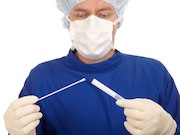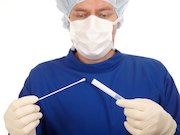Tag: Cancer: Cervical
Catch-Up HPV Doses Effective to Age 21 Against Cervical Neoplasia
But catch-up doses not effective against CIN for women who initiated vaccination at 21 to 26 years
USPSTF Updates Guidance for Cervical Cancer Screening
Cytology recommended every three years from age 21; different screening options from age 30 to 65
HPV Cervical CA Screening Cuts Odds of Later CIN3+ Diagnosis
Use of primary HPV testing results in significantly lower odds of CIN3+ compared with cytology testing
Good Evidence That HPV Vaccines Protect Against Cervical Precancer
High-certainty evidence for protection in adolescent girls and young women aged 15 to 26 years
Mortality Risk Persists for Cancer Tied to Prenatal DES Exposure
Women with DES-related clear-cell adenocarcinoma had 27-fold higher mortality at 10 to 34 years
Cervical Cancer Frequently Diagnosed After Age 65
Almost 20 percent of cervical cancer cases are diagnosed in women older than 65
Many Untreated CIN2 Lesions Regress Spontaneously
Regression of cervical intraepithelial neoplasia grade 2 lesions especially likely in younger women
Risk of ≥CIN3 Drops With Negative HPV, Cytology Co-Tests
Decrease in 5-year ≥CIN3 risks after each successive negative round of HPV, cytology co-testing
ASTRO: High-Dose Brachytherapy Effective With Four 7 Gy Fractions
Better tumor control than with two 9 Gy fractions among patients with locally advanced cervical cancer
USPSTF Backs Cervical Cancer Screening With Cytology or hrHPV
Recommendations for screening with cytology alone every three years or hrHPV testing every five years














